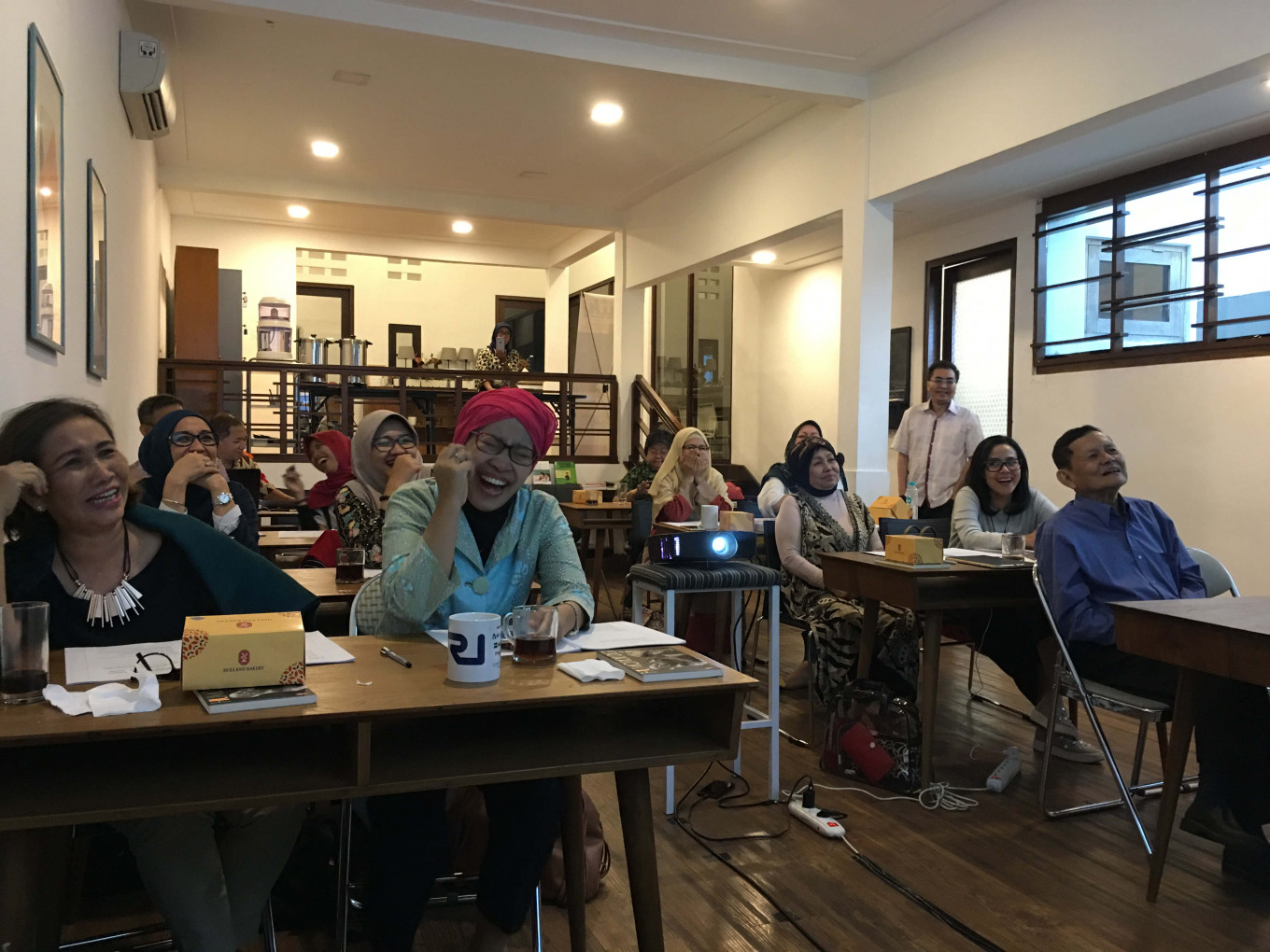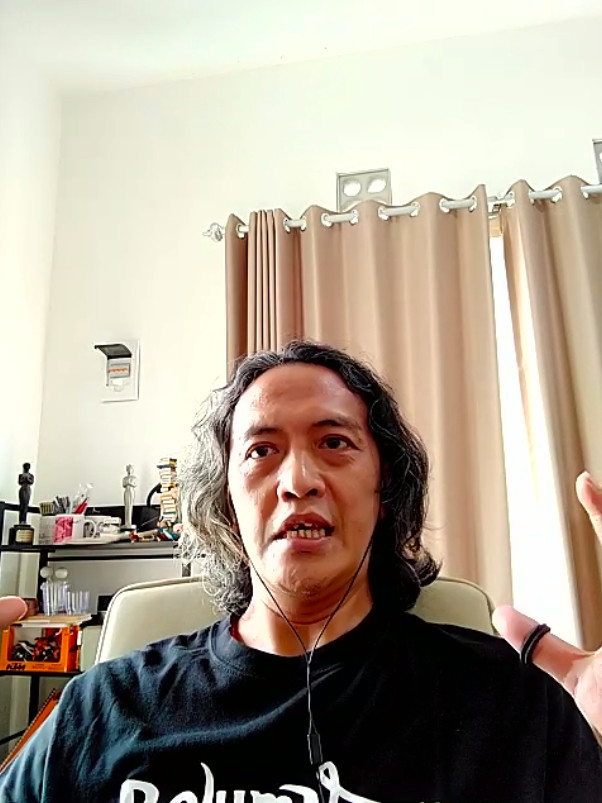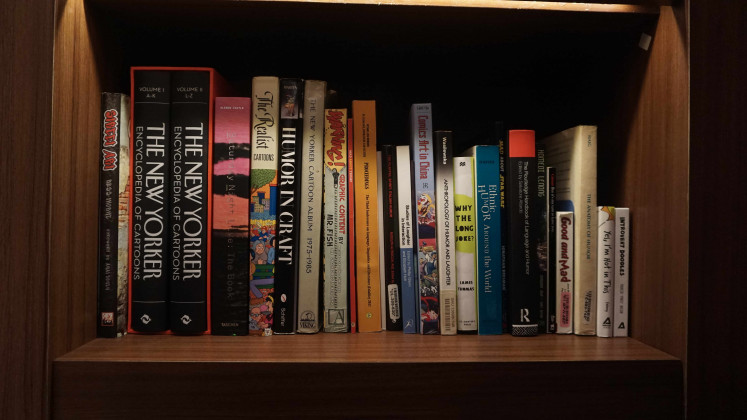Popular Reads
Top Results
Can't find what you're looking for?
View all search resultsPopular Reads
Top Results
Can't find what you're looking for?
View all search resultsThe science of telling jokes: Indonesia's first comedy institute
We visited the Indonesian Modern Humor Institute (IHIK) to answer the question: Is it possible to be funny when we don’t think we are?
Change text size
Gift Premium Articles
to Anyone
Y
ou may think of yourself as one clumsy, awkward human being and that telling jokes is not your virtue. Don’t fret, my friend, because research shows that everyone has the potential to be funny. Perhaps not up to the level of legendary stand-up comedian Dave Chappelle or Indonesian comedic icon Komeng but enough to lighten up the atmosphere. At least that’s what the Indonesian Modern Humor Institute (IHIK) believes.
Founded in March 2016 by eccentric trio Seno Gumira Ajidarma, Danny Septriadi and Darminto M. Sudarmo, IHIK has the mission to spread humor. To achieve that, it conducts various kinds of training to incorporate humor in everyday life: teaching, public speaking, presentation, therapy and negotiation, just to name a few. Along with the training, it also provides a wealth of humor-centric literature in their Library of Humor Studies in Kelapa Gading, North Jakarta.
Ulwan Fakhry, a humor researcher from IHIK, shows the collection of literature in The Library of Humor Studies. (JP/Ikhwan Hastanto)According to the trio, many people from diverse, unexpected backgrounds aspire to be funny. People from oil and gas companies, police institutions, universities, private banks, start-ups and the comedy world have signed up for IHIK’s training.
“We need to take humor seriously,” said Novrita Widiyastuti, IHIK’s CEO.
She wants people to realize that humor offers something more than entertainment.
“Humor is proven to benefit your work in [fields such as] communications, business, sociology, advertising, graphic design, anthropology, psychology, philosophy and even neuroscience,” said the 42-year-old.
She is also a lecturer at the London School of Public Relations’ marketing department and has received two Best Lecture awards for using humor in her teaching.
When asked about the fundamentals of learning comedy, IHIK divides it into separate elements.
The assessment
Learning humor is about understanding context; a joke can be funny for one person but offensive for another.
IHIK helps students understand which joke is appropriate to different people and in different spaces. Humor Researcher Ulwan Al-Fakhry gives this example: When invited to entertain American troops in Vietnam, stand-up comedian Bob Hope deployed a team beforehand to assess the situation. Hope tried his best to understand what was happening to effectively talk about things the soldiers can relate to and not be offended by.
Beng Rahadian is chairman of the Visual Communication Design Department at the Jakarta Art Institute (IKJ). About a month ago, he hired IHIK to train 38 IKJ lecturers about teaching with humor. He believes humor is applicable and relatable to all generations.
Beng Rahadian, IKJ’s Chief of the Visual Communication Design Department, gives a testimony about how humor training make his classes lively. (JP/Screenshot of Zoom interview with Beng Rahadian)“The training taught us several things. It is important to understand when to use [humor], to whom and how much. It is essential because the wrong kind of humor can ruin our teaching process,” said Beng.
He added that his fellow lecturers had learned a lot from the training, such as the boundaries for making body-shaming jokes.
Another student, Satrio Hermian Utomo, a 42-year-old operational insurance analyst at Pertamina Hulu Energi, also noticed the difference the learning process had made.
“[Taking part in the training] made me think more about the impact of the joke I’m about to tell,” said Satrio, who is often appointed to emcee for office events.
Learning from masters
We can learn a lot from a joke told by others. There is a methodology in digging deeply into a specific joke. One of them is reverse-engineering.
“We show our students an example of a funny conversation in a comic book, then we analyze the fun. After that, we erase the captions and have them fill the conversation balloons themselves with something funny,” said Ulwan.
The people of Malang in East Java believe this kind of activity will create a sense of humor in everything we do.
“Telling jokes, just like other art, is about habit.”
Tofan Dwi Satrio is a 28-year-old police officer with the West Java Police and a beneficiary of IHIK. He learned from the comedy masters that it was essential to focus on the premise first instead of the set-up and punchline.
“We need to analyze our thoughts, our anxieties and our surroundings. That is the start. Finding the joke after that’s done is much easier.”
Safe space
Because jokes are meant to be told, beginners need to have a safe space where everyone can exchange their material without fear of judgment.
“[IHIK is] a place where everyone can express anything freely,” Ulwan said.
If learning humor requires a safe space, then using it can actually create one. Beng said that after his fellow lecturers infused humor into their lessons, “the classes became lively and dynamic. The students appeared confident in exchanging jokes with their teachers.”
A glimpse of IHIK’s literature collection in The Library of Humor Studies (JP/Ikhwan Hastanto)Meanwhile, Tofan said he started to look more approachable.
“One time, an app-based driver [felt comfortable enough] to make fun of me because I had forgotten to wear my seatbelt.”
Can everyone learn?
Not all comedy practitioners think so. Comedian Ernest Prakasa underlined the importance of the comedic sense being something we cannot actually “learn”.
“In order to be funny, you have to have a sense of what is funny for a lot of people. That is, I believe, something you cannot learn. To be able to identify or to feel it. That ‘instinct’ is genetic,” Ernest said.
However, he reiterated that comedy training was still relevant and valuable.
“Because if you’re talented and you don’t have the necessary tools, you won’t go anywhere. But I don’t believe that you can really use the knowledge to make someone funny if they are not born with the talent.”
Yasser Fikry, IHIK chief creative officer, is certain that anyone can learn to be funny and that appreciation runs parallel with creation.
“If you can laugh at a joke, you can create a joke,” Yasser said.













